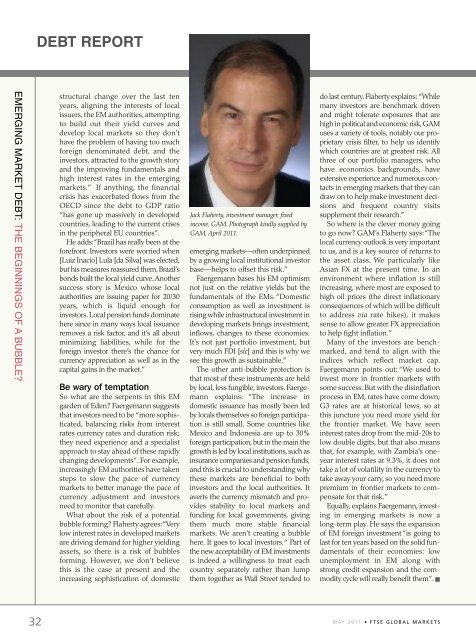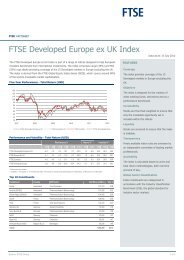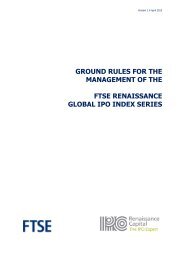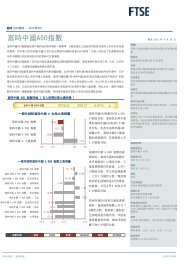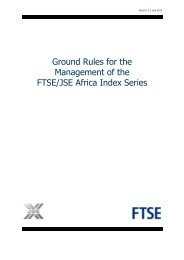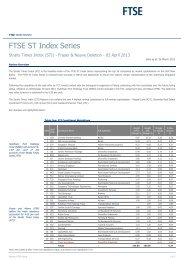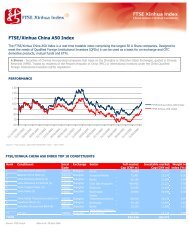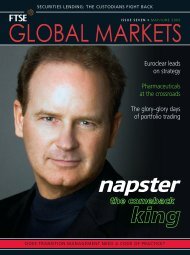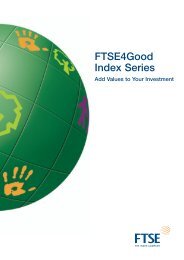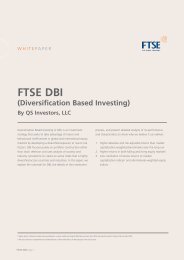The Importance Of Being Earnest - FTSE
The Importance Of Being Earnest - FTSE
The Importance Of Being Earnest - FTSE
Create successful ePaper yourself
Turn your PDF publications into a flip-book with our unique Google optimized e-Paper software.
EMERGING MARKET DEBT: THE BEGINNINGS OF A BUBBLE?<br />
32<br />
DEBT REPORT<br />
structural change over the last ten<br />
years, aligning the interests of local<br />
issuers, the EM authorities, attempting<br />
to build out their yield curves and<br />
develop local markets so they don’t<br />
have the problem of having too much<br />
foreign denominated debt, and the<br />
investors, attracted to the growth story<br />
and the improving fundamentals and<br />
high interest rates in the emerging<br />
markets.” If anything, the financial<br />
crisis has exacerbated flows from the<br />
OECD since the debt to GDP ratio<br />
“has gone up massively in developed<br />
countries, leading to the current crises<br />
in the peripheral EU countries”.<br />
He adds: “Brazil has really been at the<br />
forefront. Investors were worried when<br />
[Luiz Inacio] Lula [da Silva] was elected,<br />
but his measures reassured them. Brazil’s<br />
bonds built the local yield curve. Another<br />
success story is Mexico whose local<br />
authorities are issuing paper for 20/30<br />
years, which is liquid enough for<br />
investors. Local pension funds dominate<br />
here since in many ways local issuance<br />
removes a risk factor, and it’s all about<br />
minimizing liabilities, while for the<br />
foreign investor there’s the chance for<br />
currency appreciation as well as in the<br />
capital gains in the market.”<br />
Be wary of temptation<br />
So what are the serpents in this EM<br />
garden of Eden? Faergemann suggests<br />
that investors need to be “more sophisticated,<br />
balancing risks from interest<br />
rates currency rates and duration risk;<br />
they need experience and a specialist<br />
approach to stay ahead of these rapidly<br />
changing developments”. For example,<br />
increasingly EM authorities have taken<br />
steps to slow the pace of currency<br />
markets to better manage the pace of<br />
currency adjustment and investors<br />
need to monitor that carefully.<br />
What about the risk of a potential<br />
bubble forming? Flaherty agrees: “Very<br />
low interest rates in developed markets<br />
are driving demand for higher yielding<br />
assets, so there is a risk of bubbles<br />
forming. However, we don’t believe<br />
this is the case at present and the<br />
increasing sophistication of domestic<br />
Jack Flaherty, investment manager, fixed<br />
income, GAM. Photograph kindly supplied by<br />
GAM, April 2011.<br />
emerging markets—often underpinned<br />
by a growing local institutional investor<br />
base—helps to offset this risk.”<br />
Faergemann bases his EM optimism<br />
not just on the relative yields but the<br />
fundamentals of the EMs. “Domestic<br />
consumption as well as investment is<br />
rising while infrastructural investment in<br />
developing markets brings investment,<br />
inflows, changes to these economies.<br />
It’s not just portfolio investment, but<br />
very much FDI [sic] and this is why we<br />
see this growth as sustainable.”<br />
<strong>The</strong> other anti-bubble protection is<br />
that most of these instruments are held<br />
by local, less fungible, investors. Faergemann<br />
explains: “<strong>The</strong> increase in<br />
domestic issuance has mostly been led<br />
by locals themselves so foreign participation<br />
is still small. Some countries like<br />
Mexico and Indonesia are up to 30%<br />
foreign participation, but in the main the<br />
growth is led by local institutions, such as<br />
insurance companies and pension funds,<br />
and this is crucial to understanding why<br />
these markets are beneficial to both<br />
investors and the local authorities. It<br />
averts the currency mismatch and provides<br />
stability to local markets and<br />
funding for local governments, giving<br />
them much more stable financial<br />
markets. We aren’t creating a bubble<br />
here. It goes to local investors. “ Part of<br />
the new acceptability of EM investments<br />
is indeed a willingness to treat each<br />
country separately rather than lump<br />
them together as Wall Street tended to<br />
do last century. Flaherty explains: “While<br />
many investors are benchmark driven<br />
and might tolerate exposures that are<br />
high in political and economic risk, GAM<br />
uses a variety of tools, notably our proprietary<br />
crisis filter, to help us identify<br />
which countries are at greatest risk. All<br />
three of our portfolio managers, who<br />
have economics backgrounds, have<br />
extensive experience and numerous contacts<br />
in emerging markets that they can<br />
draw on to help make investment decisions<br />
and frequent country visits<br />
supplement their research.”<br />
So where is the clever money going<br />
to go now? GAM’s Flaherty says: “<strong>The</strong><br />
local currency outlook is very important<br />
to us, and is a key source of returns to<br />
the asset class. We particularly like<br />
Asian FX at the present time. In an<br />
environment where inflation is still<br />
increasing, where most are exposed to<br />
high oil prices (the direct inflationary<br />
consequences of which will be difficult<br />
to address via rate hikes), it makes<br />
sense to allow greater FX appreciation<br />
to help fight inflation.”<br />
Many of the investors are benchmarked,<br />
and tend to align with the<br />
indices which reflect market cap.<br />
Faergemann points out: “We used to<br />
invest more in frontier markets with<br />
some success. But with the disinflation<br />
process in EM, rates have come down;<br />
G3 rates are at historical lows, so at<br />
this juncture you need more yield for<br />
the frontier market. We have seen<br />
interest rates drop from the mid-20s to<br />
low double digits, but that also means<br />
that, for example, with Zambia’s oneyear<br />
interest rates at 9.3%, it does not<br />
take a lot of volatility in the currency to<br />
take away your carry, so you need more<br />
premium in frontier markets to compensate<br />
for that risk.”<br />
Equally, explains Faergemann, investing<br />
in emerging markets is now a<br />
long-term play. He says the expansion<br />
of EM foreign investment “is going to<br />
last for ten years based on the solid fundamentals<br />
of their economies: low<br />
unemployment in EM along with<br />
strong credit expansion and the commodity<br />
cycle will really benefit them”. ■<br />
M AY 2 0 1 1 • F T S E G L O B A L M A R K E T S


